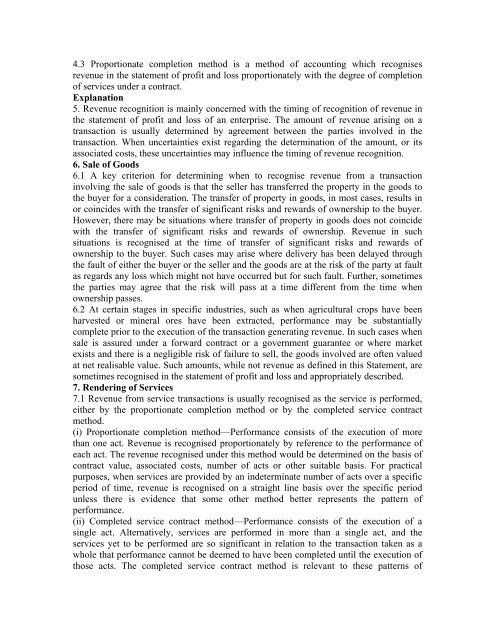Accounting Standards 1-29 - Seth & Associates
Accounting Standards 1-29 - Seth & Associates
Accounting Standards 1-29 - Seth & Associates
Create successful ePaper yourself
Turn your PDF publications into a flip-book with our unique Google optimized e-Paper software.
4.3 Proportionate completion method is a method of accounting which recognises<br />
revenue in the statement of profit and loss proportionately with the degree of completion<br />
of services under a contract.<br />
Explanation<br />
5. Revenue recognition is mainly concerned with the timing of recognition of revenue in<br />
the statement of profit and loss of an enterprise. The amount of revenue arising on a<br />
transaction is usually determined by agreement between the parties involved in the<br />
transaction. When uncertainties exist regarding the determination of the amount, or its<br />
associated costs, these uncertainties may influence the timing of revenue recognition.<br />
6. Sale of Goods<br />
6.1 A key criterion for determining when to recognise revenue from a transaction<br />
involving the sale of goods is that the seller has transferred the property in the goods to<br />
the buyer for a consideration. The transfer of property in goods, in most cases, results in<br />
or coincides with the transfer of significant risks and rewards of ownership to the buyer.<br />
However, there may be situations where transfer of property in goods does not coincide<br />
with the transfer of significant risks and rewards of ownership. Revenue in such<br />
situations is recognised at the time of transfer of significant risks and rewards of<br />
ownership to the buyer. Such cases may arise where delivery has been delayed through<br />
the fault of either the buyer or the seller and the goods are at the risk of the party at fault<br />
as regards any loss which might not have occurred but for such fault. Further, sometimes<br />
the parties may agree that the risk will pass at a time different from the time when<br />
ownership passes.<br />
6.2 At certain stages in specific industries, such as when agricultural crops have been<br />
harvested or mineral ores have been extracted, performance may be substantially<br />
complete prior to the execution of the transaction generating revenue. In such cases when<br />
sale is assured under a forward contract or a government guarantee or where market<br />
exists and there is a negligible risk of failure to sell, the goods involved are often valued<br />
at net realisable value. Such amounts, while not revenue as defined in this Statement, are<br />
sometimes recognised in the statement of profit and loss and appropriately described.<br />
7. Rendering of Services<br />
7.1 Revenue from service transactions is usually recognised as the service is performed,<br />
either by the proportionate completion method or by the completed service contract<br />
method.<br />
(i) Proportionate completion method—Performance consists of the execution of more<br />
than one act. Revenue is recognised proportionately by reference to the performance of<br />
each act. The revenue recognised under this method would be determined on the basis of<br />
contract value, associated costs, number of acts or other suitable basis. For practical<br />
purposes, when services are provided by an indeterminate number of acts over a specific<br />
period of time, revenue is recognised on a straight line basis over the specific period<br />
unless there is evidence that some other method better represents the pattern of<br />
performance.<br />
(ii) Completed service contract method—Performance consists of the execution of a<br />
single act. Alternatively, services are performed in more than a single act, and the<br />
services yet to be performed are so significant in relation to the transaction taken as a<br />
whole that performance cannot be deemed to have been completed until the execution of<br />
those acts. The completed service contract method is relevant to these patterns of




